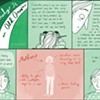Published February 1, 2013 at 4:00 a.m. | Updated April 4, 2022 at 7:34 p.m.
Children who develop food-related allergies and intolerances can experience symptoms ranging from minor tummy aches to potentially life-threatening anaphylactic shock. These reactions are more common today than they were 30 years ago, and parents, school officials and health care providers have adapted new ways of managing them — peanut-free school lunchrooms and gluten-free cafeteria menus are two examples.
This month, Dr. Lewis First, chief of pediatrics at Vermont Children's Hospital at Fletcher Allen Health Care, touches on what parents should know about how these diet-related disorders affect children.
KIDS VT: What's the difference between food allergies and food intolerances?
LEWIS FIRST: A food allergy is a condition in which the body develops a reaction to a food that causes the release of chemicals, called histamines, that result in a true allergic reaction. In mild cases, this can be itchiness, tingling of the lips, rashes or hives. In more severe cases, the reaction can cause swelling of body parts, difficulty breathing and shock. It can be life threatening.
A food intolerance is more a problem with digesting food appropriately. It doesn't release histamines but results in inflammation in the digestive tract.
KVT: What are the most common food allergies and intolerances?
LF: Peanuts, nuts, seafood, eggs and soy are the most common food allergies. Celiac disease and lactose intolerance are the most common food intolerances.
KVT: What is lactose intolerance?
LF: It's the inability of the body to break down lactose, found in many dairy products, into simple sugars. If you can't break down lactose into simple sugars, it cannot get absorbed and "goes out the back." That's why you get a lot of bloating, gas, cramps and diarrhea.
KVT: What causes celiac disease or gluten intolerance?
LF: Gluten is a group of proteins found in wheat, rye and barley. It's one of the most-consumed products in our diets, second only to sugar. When someone is unable to tolerate gluten, the body produces antibodies that fight against it, which also fight against and flatten the lining of the intestines. That makes absorbing nutrients and vitamins difficult. Both celiac and lactose intolerance produce bloating, abdominal pain, excessive gas, fatigue and even weight loss.
KVT: Can celiac or lactose intolerance create nutritional problems?
LF: With celiac, a child may not gain weight. Malnutrition and even anemia may become issues as the gut is inflamed.
With lactose intolerance, there are simple ways to replace what the child is not getting from dairy products. With kids, we need to be sure they're getting enough calcium and vitamin D. So as long as your child gets enough calcium through other foods such as broccoli, calcium-fortified juices, some cheeses and lactose-free dairy products, he or she will be OK.
KVT: Are celiac disease and lactose intolerance easy to diagnose?
LF: No. Since they have many of the same symptoms, it can be like playing a game of Clue. Initially, a family may have multiple suspects in play. Most kids are going to have a mix of grains, dairy products and maybe some shellfish in their diet.
Parents should be sensitive to when their kids don't feel good, and begin to play detective. For example, if kids feel uncomfortable right after eating dairy products, that should raise suspicions for lactose intolerance. Confirmation requires a type of breathing test, in which children drink a certain kind of milk, and then a doctor measures the hydrogen and methane levels in their breath. For celiac, blood tests allow doctors to make that diagnosis. However, as this is a lifetime disorder, parents want to be absolutely sure and so will usually have their child's intestines sampled with a biopsy, since occasionally a blood test may produce a false positive.
KVT: Do food allergies or intolerances change over time?
LF: They can. Most kids outgrow egg and soy allergies by age 5. But the peanut, tree nut, seafood, celiac disease and lactose intolerance are pretty much with you for life. People should understand that peanuts and tree nuts are not the same, as peanuts aren't really nuts but legumes. So not every child who has a problem with peanuts is going to have a problem with cashews.
KVT: Do food allergies get progressively worse with each reaction?
LF: No. The idea that if you've had one, the next one is going to be worse, like a bee sting, hasn't been shown to be true. But any child who has had an allergic reaction to food should have ready access to an EpiPen (epinephrine autoinjector). Schools, friends and daycare providers must be made aware of the food allergy, and school-age children should be carrying their own EpiPens and know how to use them. Every child with a food allergy should also have a MedicAlert bracelet that identifies what he or she is allergic to and its treatment. Any time an EpiPen is used, the child should still go to the emergency department, because he or she may still have a recurrent reaction within a couple of hours once the epinephrine wears off.
Got questions for Dr. First? Send them to [email protected].
This article was originally published in Seven Days' monthly parenting magazine, Kids VT.
More By This Author
Speaking of...
-

How Can Parents Ease Kids' COVID-19 Anxieties About Returning to School?
Aug 24, 2021 -

How Can Parents Prevent and Treat Common Summertime Burns?
Jun 29, 2021 -

Should You Adjust Your Parenting Style to Your Child's Personality?
Jun 1, 2021 -

What Should Pregnant & Nursing Women Know About COVID-19?
May 4, 2021 -

Should Parents Be Concerned About Kids' Pandemic Weight Gain?
Apr 6, 2021 - More »
Comments
Comments are closed.
From 2014-2020, Seven Days allowed readers to comment on all stories posted on our website. While we've appreciated the suggestions and insights, right now Seven Days is prioritizing our core mission — producing high-quality, responsible local journalism — over moderating online debates between readers.
To criticize, correct or praise our reporting, please send us a letter to the editor or send us a tip. We’ll check it out and report the results.
Online comments may return when we have better tech tools for managing them. Thanks for reading.













































